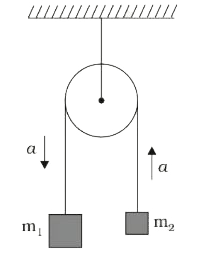After absobing a slowly moving neutron of mass mN (mometum ~0), a nucleus of mass M breaks into two nuclei of masses m1and5m1(6m1=M+mN), respectively. If the de - Broglie wavelength of the nucleus with mass m1 is λ, then de - Broglie wavelength of the other nucleus will be
5λ
λ/5
λ
25λ
The correct Answer is:C
Pi=0⇒Pf=P1+P2
Pi=Pf⇒0=P1+P2
(P1=−P2)⇒λ1=hP1
λ2=hP2
⇒|λ1|=|λ2|
⇒λ1=λ2=λ
Topper's Solved these Questions
- DAILY PRACTICE PROBLEMBOOK - RESONANCE ENGLISHCHAPTER - DAILY PRACTICE PROBLEMEXERCISE - DPP No.18
9 Videos
- DAILY PRACTICE PROBLEMBOOK - RESONANCE ENGLISHCHAPTER - DAILY PRACTICE PROBLEMEXERCISE - DPP No.19
20 Videos
- DAILY PRACTICE PROBLEMBOOK - RESONANCE ENGLISHCHAPTER - DAILY PRACTICE PROBLEMEXERCISE - DPP No.16
9 Videos
- CURRENT ELECTRICITYBOOK - RESONANCE ENGLISHCHAPTER - CURRENT ELECTRICITYEXERCISE - High Level Problems (HIP)
19 Videos
- ELECTRO MAGNETIC WAVESBOOK - RESONANCE ENGLISHCHAPTER - ELECTRO MAGNETIC WAVESEXERCISE - Exercise 3
27 Videos
Similar Questions
After absorbing a slowly moving neutrons of mass mN (momentum ~0) a nucleus of mass M breaks into two nucleii of mass m1and5m1(6m1=M+mN), respectively . If the de-Broglie wavelength of the nucleus with mass m1 is λ, then de Broglie wavelength of the other nucleus will be
View SolutionTwo bodies of masses m1andm2(<m1) are connected to the ends of a massless cord and allowed to move as shown in figure. The pulley is both massless and frictionless. The acceleration of the centre of mass is (m1−m2)n(m1+m2)2g. Find the value of n.

View Solution
Knowledge Check
Two particles A1andA2 of masses m1,m2(m1>m2) have the same de-broglie wavelength. Then
Atheir momenta are the same.Btheir energies are the same.Cmomentum of A1 is less than the momentum of A2.Denergy of A1 is more than the energy of A2.A particle of mass 4m at rest decays into two particles of masses m and 3m having non-zero velocities. The ratio of the de Broglie wavelengths of the particles 1 and 2 is
A12B14C2D1
The de-Broglie wavelength of a particle with mass 1g and velocity 100m/sec is.
View SolutionA praticle of mass M at rest decays into two particle of masses m1 and m2, having non-zero velocities. The ratio of the de Broglie wavelength of the particles λ1λ2 is
View SolutionTwo particles A1andA2 of masses m1,m2(m1>m2) have the same de-broglie wavelength. Then
View SolutionA particle of mass 3m at rest decays into two particles of masses m and 2m having non-zero velocities. The ratio of the de Broglie wavelengths of the particles (λ1λ2) is
View SolutionThe de - Broglie wavelength associated with the particle of mass m moving with velocity v is
View SolutionThe atomic masses of He and Ne are 4 and 20 amu respectively . The value of the de Broglie wavelength of He gas at−73.∘C is ''M'' times that of the de Broglie wavelength of Ne at 727.∘C. M is
View Solution
